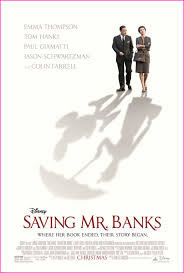MOVIE REVIEW
Saving Mr. Banks
By Jan Aaron
 A plot about a dispute between a writer and a studio director over the artistic direction for a movie sounds yawn-inducing. But, if the writer is the cranky and curt, P.J. Travers, author of “Mary Poppins,” and the studio chief is Walt Disney, it commands our attention.
A plot about a dispute between a writer and a studio director over the artistic direction for a movie sounds yawn-inducing. But, if the writer is the cranky and curt, P.J. Travers, author of “Mary Poppins,” and the studio chief is Walt Disney, it commands our attention.
The director of Saving Mr. Banks, John Lee Hancock, also faced a major obstacle: How do you make an engrossing movie when you already know how it ends? Even more challenging however, was making a genial film about a cantankerous female author (Travers) going through one of the most challenging periods of her life?
The film doesn’t exactly adhere to historical record, but brings it all together successfully with a “spoonful of sugar” to sweeten the truth and a performance by Emma Thompson that ignites the screen. Though co-star Tom Hanks plays a wonderful Walt Disney, it’s Thompson’s movie. Her face; perfectly powdered, her hair in tight curls, lips frozen in crimson; she insists everyone – including Walt Disney – address her as Mrs. Travers.
Script-writers Kelly Marcel and Sue Smith give her great lines. She is the kind of frank woman who comes right out and asks a young mother on the airplane to Los Angeles: “Will the child be a nuisance?” Not impressed with the giant Mickey Mouse and balloons in her Beverly Hills Hotel suite, she pitches them and a basket of fruit out the window into the hotel’s pool, astonishing the swimmers and sunbathers.
Most of the movie deals with the weeks in 1961, when Travers, in serious financial trouble, comes from London to Los Angeles to consider selling the rights to “Poppins,” and meets with the songwriting team’s Sherman Brothers (Jason Schwartzman and B.J. Novak) and screenwriter Don DaGradi (Bradley Whitford.) “These books do not lend themselves to chirping and prancing,” she says. She disdains when Dick Van Dyke is called “one of the greats,” as she finds Laurence Olivier of Othello a true idea of a great actor.
The screenwriter’s script goes back and forth between the Los Angeles period and the Australian childhood of Helen Goff (newcomer Annie Rose Buckley), the little girl who grew up to become P.J. Travers. The script tells us that the idea for Mary Poppins came from Travers’ childhood but it revealed that her troubles with Disney stem from unresolved childhood issues.
How then did this movie ever get made with all the disagreements? It is Disney himself who comes to the rescue with a speech about the healing power of storytelling. #
